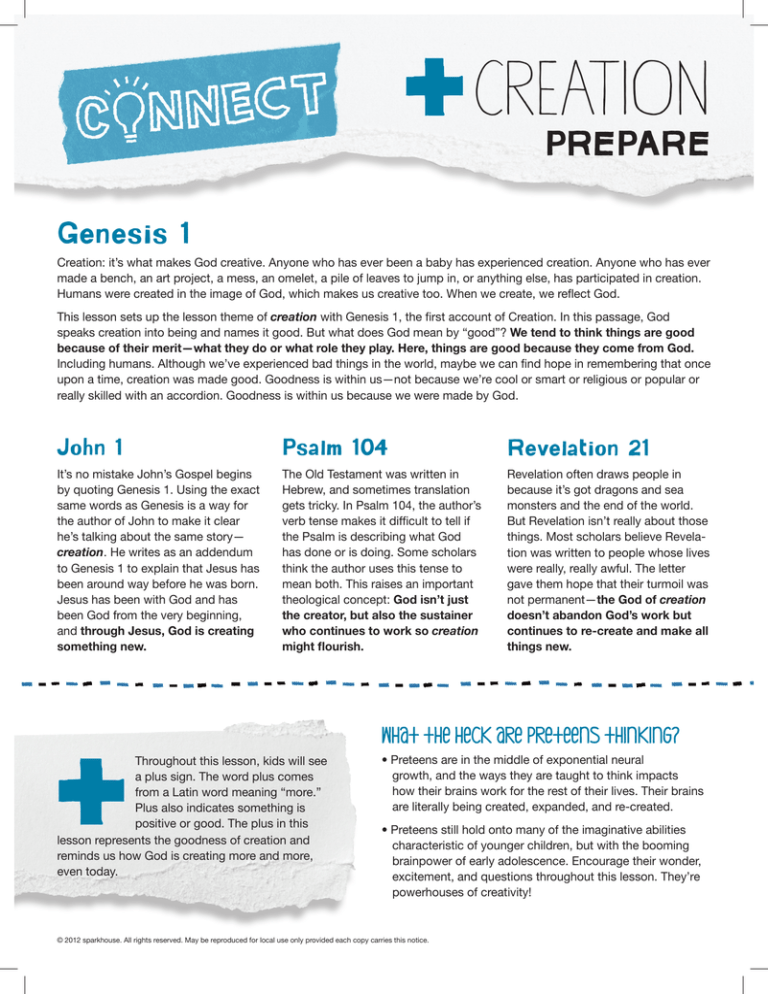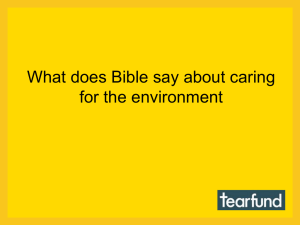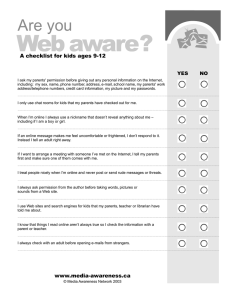
CREATION
PREPARE
Genesis 1
Creation: it’s what makes God creative. Anyone who has ever been a baby has experienced creation. Anyone who has ever
made a bench, an art project, a mess, an omelet, a pile of leaves to jump in, or anything else, has participated in creation.
Humans were created in the image of God, which makes us creative too. When we create, we reflect God.
This lesson sets up the lesson theme of creation with Genesis 1, the first account of Creation. In this passage, God
speaks creation into being and names it good. But what does God mean by “good”? We tend to think things are good
because of their merit—what they do or what role they play. Here, things are good because they come from God.
Including humans. Although we’ve experienced bad things in the world, maybe we can find hope in remembering that once
upon a time, creation was made good. Goodness is within us—not because we’re cool or smart or religious or popular or
really skilled with an accordion. Goodness is within us because we were made by God.
John 1
Psalm 104
Revelation 21
It’s no mistake John’s Gospel begins
by quoting Genesis 1. Using the exact
same words as Genesis is a way for
the author of John to make it clear
he’s talking about the same story—
creation. He writes as an addendum
to Genesis 1 to explain that Jesus has
been around way before he was born.
Jesus has been with God and has
been God from the very beginning,
and through Jesus, God is creating
something new.
The Old Testament was written in
Hebrew, and sometimes translation
gets tricky. In Psalm 104, the author’s
verb tense makes it difficult to tell if
the Psalm is describing what God
has done or is doing. Some scholars
think the author uses this tense to
mean both. This raises an important
theological concept: God isn’t just
the creator, but also the sustainer
who continues to work so creation
might flourish.
Revelation often draws people in
because it’s got dragons and sea
monsters and the end of the world.
But Revelation isn’t really about those
things. Most scholars believe Revelation was written to people whose lives
were really, really awful. The letter
gave them hope that their turmoil was
not permanent—the God of creation
doesn’t abandon God’s work but
continues to re-create and make all
things new.
What the heck are preteens thinking?
Throughout this lesson, kids will see
a plus sign. The word plus comes
from a Latin word meaning “more.”
Plus also indicates something is
positive or good. The plus in this
lesson represents the goodness of creation and
reminds us how God is creating more and more,
even today.
• Preteens are in the middle of exponential neural
growth, and the ways they are taught to think impacts
how their brains work for the rest of their lives. Their brains
are literally being created, expanded, and re-created.
• Preteens still hold onto many of the imaginative abilities characteristic of younger children, but with the booming
brainpower of early adolescence. Encourage their wonder, excitement, and questions throughout this lesson. They’re powerhouses of creativity!
© 2012 sparkhouse. All rights reserved. May be reproduced for local use only provided each copy carries this notice.
CREATION
Warm up
Supplies: cereal
1. Pair up. Give each pair some pieces of cereal (small, strong square
cereals may work best—or offer a variety for kids to choose from).
2. Challenge the group to a field goal contest. One partner uses thumbs
and forefingers to make a goalpost, while the other partner tries to flick
a cereal piece through the goal. The person making the goalpost
should open his or her mouth and try to catch the cereal in his or her
mouth.
3. “Kick” the cereal through the goal posts and the team gets 3 points.
(No cheating—the goalpost can’t move!) If the person making the goal
post also catches the cereal in his or her mouth, the team gets an
additional 3 points. Whenever a team scores, they shout, “And it’s
GOOD!” like a sportscaster.
SEE
(10-15 MIN.)
Leader Tip
If you have a group of guys or girls
who are disruptive when they sit
together, pair up girl-guy. After
the game is over, ask pairs to stay
where they are in the room.
Variation
Instead of cereal, use paper folded
into a triangle or crumpled up. (But
omit having kids catch the paper in
their mouths!)
Ask kids about food allergies and
offer an alternative if necessary.
4.Alternate turns as kicker and goalpost. The first team to make it to
15 points wins.
Video
Supplies: Creation lesson video, whiteboard/chart paper, markers
1.
As a group, come up with a creative definition of “creation.” Write the
definition on a whiteboard or chart paper.
• What does creation have to do with creativity?
2.
Watch the video, “Creation.”
3.
Revisit the group’s definition of creation. What would kids change
after seeing the video? Then process it with the group.
• In addition to what you saw in the video, what are some good
things in creation?
• Name one thing you created in the past week.
• What other things do you see being created today?
© 2012 sparkhouse. All rights reserved. May be reproduced for local use only provided each copy carries this notice.
Leader Tip
Students may joke about things
in creation that aren’t good (like
mosquitoes?) or may raise serious
questions about painful things like
disease and death. While it’s
important to hear and honor these
points, you might want to tell the
group the next lesson (Fall) dives
into what happens when creation
goes wrong. This week focuses
on what was good from the start
of God’s creation.
CREATION
EXPLORE
(15 MIN.)
Genesis 1
Supplies: Bibles, pens or pencils, colored pencils or Bible highlighters
Your kids’ Bibles are good, but they’re even better when the pages are underlined, scribbled, annotated, drawn in, and
otherwise marked with their creative stamp. To illustrate this and make a point about the scriptures, ask the students to
break out a colored pencil or marker. In an early page of the Bible, encourage them to make a big plus sign across the
page. This book is the word of God. It is definitely good!
1.
Read Genesis 1:1–5 aloud.
2.
Look at the Creation summary in the Bible sampler. Ask a volunteer or two to read the page to the group.
3.
Follow the instructions to mark a plus sign in Genesis 1 whenever God says, “It is good.”
• Why do you think God says all these things are good?
• What different thing does God say in verse 31? Why do you think God calls it “very good”?
John 1
Psalm 104
Creation is talked about in the New Testament too! In
fact, the New Testament refers to the Old Testament
many times, reminding readers how the events of the
New Testament build upon the Old. Turn to John 1 to
see how the New Testament authors teach more about
what happened “in the beginning.”
Creation is more than just something that happened a
long time ago. In order to keep creation going, God keeps
creating, which means that God creates more to keep
creation going, which means…
1.
Jump to John 1 and read verses 1–5.
2. In the space in the Bible, ask kids to draw or write
about what’s being created in this passage.
• Why does John focus so much on light and
darkness when Genesis talks about so many
other things in creation?
1.
Turn to Psalm 104 and read verses 14–23 and 30.
2.
Circle something God created. Then draw an arrow to
the thing(s) that benefit from the stuff God created.
(Kids may end up with arrows all over the page. That’s
a good thing!)
• What are some ways you see different parts of
creation connect together and support each other?
• How would you draw “the Word of God”?
p More Time?
Revelation 21
God isn’t just creating the same old thing over and over again. Something new is on the horizon. Some of it seems to be altogether new, and at other times, it seems God is re-creating (maybe recycling or “upcycling”!) to make old things new.
1.
Read Revelation 21:1–5.
2. Highlight verse 5 where God says, “Behold, I make all things new.”
3. In the Bible margin, write three things you wish God would make new in your life.
© 2012 sparkhouse. All rights reserved. May be reproduced for local use only provided each copy carries this notice.
CREATION
Project
Supplies: Creation Learner Sheets, scissors, markers or
colored pencils, tape, string, (optional office/craft supplies)
After talking a lot about creation and creating, it’s time to be doers of the word!
To inject energy into the room, consider tossing candy to kids as supplies are
handed out. Encourage students to share/recycle supplies and ideas. Who
knows…maybe they’ll add the candy to their project!
As kids create their projects, use these questions to help them engage their
minds and connect with one another.
• What kind of patterns can you construct with your cutouts?
• Do you plan what it will look like or just “let it happen” as you build? Why?
• One of the things God created was Sabbath and rest. Why do you think God
made Sabbath? What’s good about it?
• Art can make a statement about it’s surroundings. Where should your work of
art be displayed? In a house, in a car, on a person, connected to another
person’s project, on a wall, hanging from a ceiling? Why?
• Time to brag about your cool work! What’s something cool about your project
that you want others to notice?
Closing Ritual
Supplies: Blue marker
Set the projects aside and stand in a circle. Remind kids that they are not just good.
They’re very good. God created them that way.
MAKE
(20-30 MIN.)
1
On each plus symbol, draw
something in the world that
is good.
2
Cut out each plus, including
the small slits on each arm.
3
Make a sculpture of your
shapes by connecting the
slits together.
4
Share your sculpture with
the group.
1.
Use a blue marker and make a plus sign on the left palm of the person to your right. Say, “(insert name), you are good.”
2.
Pass the marker to that person to draw a plus sign on the next person’s hand
and say he or she is good.
Leader Tip
3.
Continue around the circle. When the marker comes back to you, say to
the group, “Remember that God made us, and together, we are very
good. Amen.”
Encourage creativity!
When a student does
something particularly
creative—adds lip gloss,
tapes a plus sign on a
friend, combines art with
someone else, draws things
that people think are bad
but are actually good—point
it out to the group as a way
of encouraging others to
be creative as well.
© 2012 sparkhouse. All rights reserved. May be reproduced for local use only provided each copy carries this notice.


